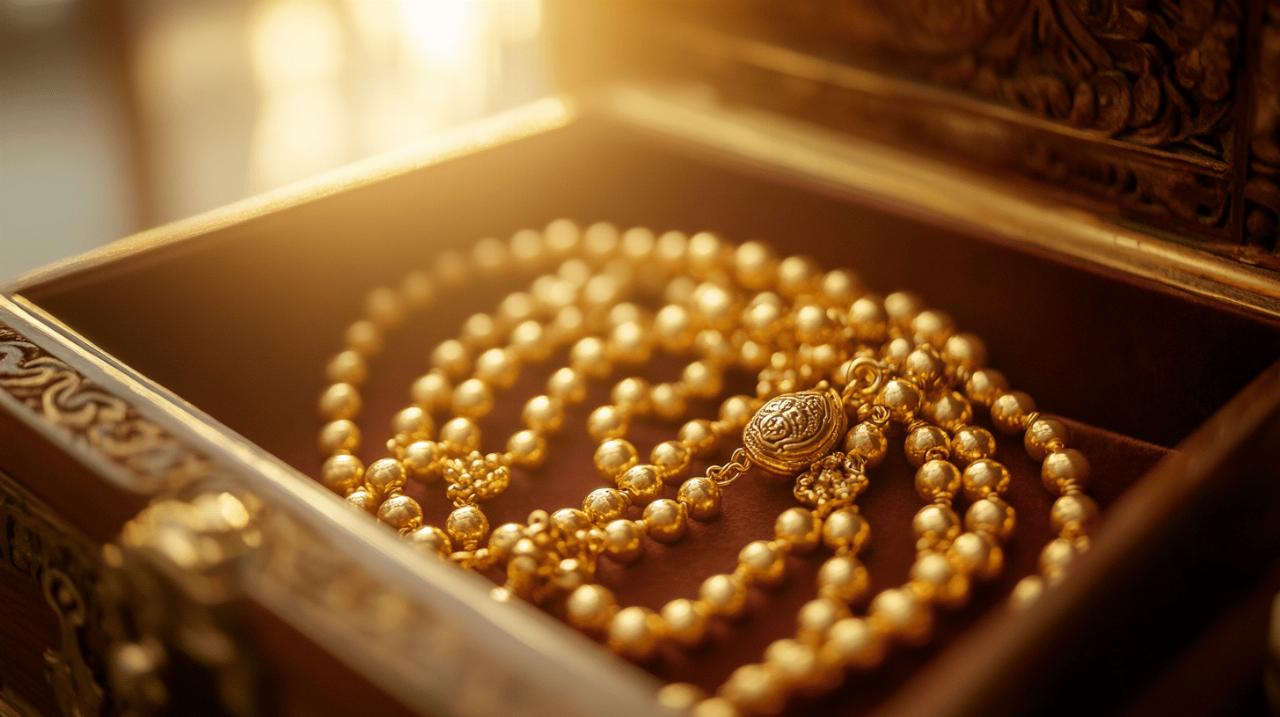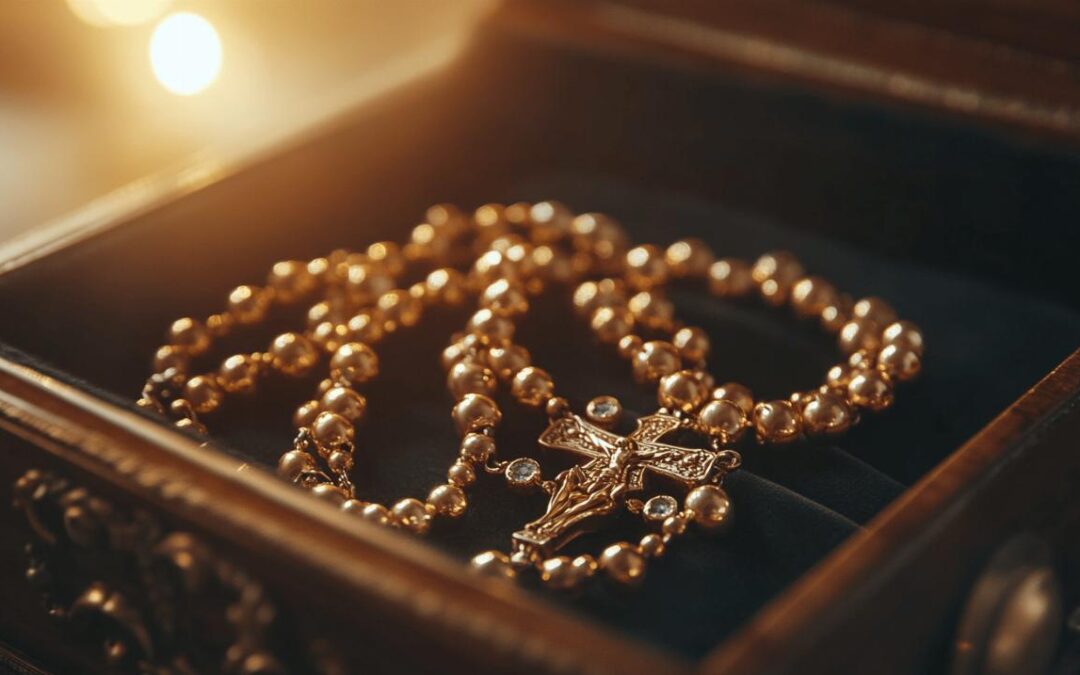Throughout history, sacred objects have held profound meaning for people of faith, serving as tangible connections to spiritual practices and beliefs. Among these treasured religious items, the Chapelet Or Traditionnel, or traditional gold rosary, stands as one of the most enduring symbols of devotion, combining both spiritual significance and artistic craftsmanship that has transcended generations.
The Rich History and Spiritual Significance of the Rosary
The rosary represents more than just a beautiful piece of religious jewelry; it embodies centuries of Catholic tradition and serves as a physical guide for prayer. This devotional tool connects believers to their faith through tactile experience, creating a bridge between physical reality and spiritual practice. The beads themselves become companions in one's spiritual journey, often passed down through families as precious heirlooms.
Ancient origins and evolution throughout centuries
The rosary's roots extend deep into Christian history, evolving from simple prayer counting methods used by early desert monks. By the Middle Ages, it had developed into a structured prayer system that allowed the faithful to participate in meditative devotion regardless of literacy levels. Over time, the design and materials used in crafting rosaries reflected both religious symbolism and artistic trends of their periods. What began as knotted ropes transformed into carefully crafted pieces featuring precious metals and gemstones, each element chosen for both beauty and symbolic meaning.
The rosary's role in daily devotional practices
In daily life, the rosary serves as a powerful tool for spiritual warfare and personal prayer. Many devout Catholics incorporate rosary prayers into their regular routines, using this structured meditation to focus their thoughts on sacred mysteries while seeking divine guidance. The physical act of moving from bead to bead creates a rhythm that helps quiet the mind and opens the heart to mystical spirituality. Beyond individual practice, the rosary fosters community bonds when prayed in groups, strengthening Catholic identity through shared tradition.
Craftsmanship and Materials: The Art of Rosary Making
The creation of a traditional Chapelet Or (Golden Rosary) represents one of the most revered forms of religious artisanship in Catholic tradition. This sacred object serves not merely as a tool for prayer but as a physical embodiment of one's spiritual journey and Catholic identity. Craftsmen who dedicate themselves to rosary making often approach their work with the same devotion that practitioners bring to prayer, understanding that each bead represents a moment of connection with the divine. The meticulous attention to detail reflects the Thomistic ethos that values both beauty and function in service of spiritual warfare against worldly distractions.
The process begins with selecting materials that honor the sacred purpose of the rosary. Many artisans work within traditions passed down through generations, incorporating techniques that date back centuries while serving the needs of modern faithful seeking tangible connections to their religious heritage. This dedication to craft mirrors the commitment of organizations like the Society of Ignatians, who embrace tradition as thoroughly modern—not as an antiquated practice but as a living, breathing approach to salvation and spiritual formation.
Precious Metals and Gemstones: Silver, Mother-of-Pearl, and Beyond
The finest traditional rosaries feature precious metals that stand the test of time, much like the Catholic truths they help practitioners contemplate. Sterling silver remains a popular choice for chains and crucifixes, offering both durability and a lustrous appearance that develops character with use. Some rosary makers incorporate 18k gold elements for special pieces, particularly for significant life events or ordinations of those entering priesthood.
Mother-of-pearl beads hold special significance in many traditional designs, their iridescent surfaces capturing light in ways that seem to reflect the mystical spirituality of deep prayer. These natural materials connect the faithful to God's creation while providing a tactile experience that enhances focus during meditation. Other gemstones commonly featured include:
Lapis lazuli, with its deep blue reminiscent of Mary's traditional garments
Pearls symbolizing purity and the gates of heaven
Amethyst representing penance and preparation
Rose quartz embodying divine love
Each material selection carries weight beyond aesthetic appeal, becoming part of the prayer experience itself. When a person holds their rosary during moments of spiritual warfare or contemplation of Catholic truth, these materials provide sensory connections that ground their practice in physical reality while elevating their thoughts toward the divine.
Symbolism behind material choices in traditional rosaries
The materials selected for a Chapelet Or Traditionnel speak volumes about Catholic symbolism and personal devotion. Gold, for instance, represents divinity and the incorruptible nature of God—a physical reminder of what we seek through missionary work and prayer. Silver symbolizes purity and redemption, echoing the spiritual formation sought by faithful Catholics.
Even the construction method carries meaning. Hand-linked rosaries, where each bead is individually connected with wire, represent the unbroken chain of faith that connects believers through time. This meticulous process mirrors the dedicated training influential priests undertake to lead others toward salvation.
The center medal typically depicts Mary or saints relevant to the owner's devotion, serving as a focal point for leadership in faith and personal connection to Catholic tradition. The crucifix design may vary from simple and austere to ornately detailed, often featuring the Five Wounds of Christ that some spiritual communities particularly venerate.
Weight also carries significance—a substantial rosary serves as a physical reminder of one's commitment to faith, while lighter versions accommodate daily carry and constant prayer. Many traditional rosaries feature beads of varying sizes to guide the practitioner through the rhythm of prayers, with larger beads marking transitions between mysteries.
This intentional symbolism transforms a beautiful object into a profound spiritual tool. When passed down through generations, these rosaries become not just personal prayer aids but tangible links to family faith history, connecting practitioners to both their heavenly and earthly families in a physical manifestation of Catholic identity and tradition.
Diversity in Design: Exploring Different Types of Rosaries
 The rosary stands as one of the most recognizable symbols of Catholic devotion, with its distinct pattern of beads arranged for the purpose of prayer and contemplation. This sacred item has evolved throughout history while maintaining its spiritual significance. The Chapelet Or Traditionnel represents the pinnacle of this devotional tradition, serving as both a prayer aid and a cherished religious heirloom that connects generations of faithful.
The rosary stands as one of the most recognizable symbols of Catholic devotion, with its distinct pattern of beads arranged for the purpose of prayer and contemplation. This sacred item has evolved throughout history while maintaining its spiritual significance. The Chapelet Or Traditionnel represents the pinnacle of this devotional tradition, serving as both a prayer aid and a cherished religious heirloom that connects generations of faithful.
In Catholic tradition, the rosary serves as a tangible guide through prayer, helping the faithful meditate on sacred mysteries while engaging in spiritual warfare against worldly temptations. Its use dates back centuries, with various religious orders such as those influenced by Ignatian spirituality embracing it as an essential tool for spiritual formation and salvation.
The materials used in crafting rosaries carry deep symbolism. Traditional rosaries often feature precious metals like gold or silver, representing purity and the value of prayer. Mother-of-pearl beads symbolize the waters of baptism, while stones such as lapis lazuli and pearls have long been associated with heavenly virtues. Each material choice enhances both the aesthetic appeal and spiritual meaning, transforming a functional prayer tool into a beautiful expression of faith.
Modern adaptations: stainless steel chains and contemporary styles
Today's rosaries have embraced contemporary materials and designs while honoring their sacred purpose. Stainless steel chains offer durability and a sleek, modern appearance that appeals to younger Catholics seeking to express their Catholic identity in a contemporary way. These modern adaptations make the rosary more accessible and practical for daily use while maintaining the Thomistic ethos that values both beauty and function.
The fusion of traditional prayer practices with modern materials creates rosaries that are both timeless and relevant. Some contemporary designs feature minimalist aesthetics, while others incorporate color coding to assist those new to this form of prayer. Despite these innovations, the fundamental purpose remains unchanged—to guide the faithful through meditation on the mysteries of salvation and deepen their mystical spirituality.
Many Catholic men and women, inspired by the examples of influential priests throughout history, carry these modern rosaries as daily reminders of their faith commitment. Like the Society of Ignatians, who value both tradition and effective outreach, these contemporary rosary designs bridge ancient practices with present-day missionary work.
Pendants and Medals: Personal Touches for a Sacred Item
Personalization through pendants and medals transforms a rosary from a standard devotional item into a unique expression of individual faith. Many rosaries feature medals of patron saints, providing a connection to these spiritual role models who exemplify Catholic truth and virtuous leadership. The Miraculous Medal, St. Benedict Medal, and Sacred Heart are among the most cherished additions, each carrying specific prayers and protections.
Family rosaries often bear medals that commemorate significant moments in spiritual life—baptisms, first communions, or pilgrimages to sacred sites. These personal touches create a legacy item that carries not just prayers but family history, becoming more precious with each generation. Some medals are associated with specific devotions within Catholic tradition, such as the Five Wounds of Christ, which holds special significance in certain spiritual practices.
Custom pendants may also feature personalized engravings of names, dates, or brief prayers, making each rosary uniquely meaningful to its owner. This personalization echoes the Catholic understanding that while the faith is universal, each person's spiritual journey is distinct. Just as the Traditional Latin Mass provides a framework for worship while allowing for deep personal encounter with God, these customized rosaries facilitate both standardized prayers and individual spiritual warfare against the challenges of modern life.

